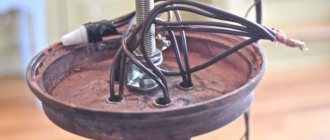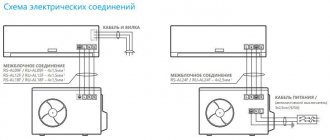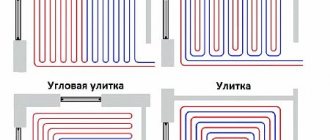The renovation has been completed, and it becomes necessary to connect the lighting fixtures to the electrical network. The home master faces a serious question: how to connect a chandelier with 3 wires. At first glance, the task does not seem too difficult. But if the number of wires coming out of the ceiling is more or less than that of the light source, they are of different colors, then it will be quite problematic for an uninitiated person to figure it out.
An incorrect connection may result in electric shock or short circuit. A job well done will allow you to enjoy the bright light of the lamps.
Wire marking
The wiring of a modern apartment is done with a three-core wire - this is a phase, neutral, grounding cable. According to the rules established by the European Committee for Electrotechnical Standardization, Russia, European countries, China, the marking is as follows:
- yellow-green, green, yellow – protective zero, the Latin “PE” is written on the diagrams;
- blue tint indicates neutrality of the wire (working zero), designation “N”;
- grey, black or brown, transfers phase voltage, "L".
It is logical for Russia after 2009, but in other countries the marking may differ; it depends on the date of manufacture of the electrical appliance or the laying of cable routes indoors. When construction was underway in the Soviet Union, wiring was laid in the colors available, most often white. Therefore, you need to be able to determine the meaning of the wires inside the chandelier sticking out from the ceiling.
Tools
To hang and connect the lamp, you will need the following tools:
- A multimeter or indicator screwdriver will be required if you need to determine the purpose of the contacts.
- Terminal clamps or caps are used for reliable connections.
- Pliers.
- Marker.
- Screwdriver.
Connection
You also need a stepladder that has a suitable height for the work.
Necessary equipment
Before starting work, prepare the necessary tools:
- voltmeter*;
- ohmmeter*;
- indicator screwdriver;
- stripping knife;
- pliers;
- insulating tape;
- terminal block;
- electrical insulating tubes (cambrics);
- stepladder or table.
* these measuring instruments are components of multimeters, which can also be used to test electrical circuits.
Precautionary measures
Be careful when connecting any electrical devices. All connections and connections must be made only with the switch turned off after checking that there is no voltage on the wires. Places where there will be twists must be insulated with insulating tape or special caps. If you doubt that you can connect a chandelier with three wires correctly, you should entrust this task to professionals.
Determination of conductor ownership
To determine the purpose of the core and be sure how to connect it correctly, you will have to tinker. There are no difficulties with two wires of the same color sticking out of the wall. If they are mixed up, the current in the cartridge will be supplied not to the central part, but to the side lobe. The lamps will be on. If there are more conductors, an incorrect connection will not allow the lights to come on or the introductory circuit breakers in the apartment will be knocked out.
The purpose of the conductor is determined using a special indicator screwdriver. One finger is pressed against the end of the device, with the tip touching the conductor. When the indicator lights up, it indicates a phase conductor. Be sure to recheck with the switch off; the light should not light up.
If there are three separate cables coming out of the ceiling, there are two options:
- a double lighting circuit is used - when different switch keys are pressed, different groups of lamps light up;
- a power supply circuit with a protective zero is used - if a short circuit or flooding occurs, a special automatic device is triggered, turning off the electrical energy, preventing electric shock.
In the first case, the check is carried out with an indicator screwdriver. In the second, you will need a socket with a screwed-in lamp with an attached cable. Having found out the location of the phase, it is connected through a test lamp to the remaining ones, the light is on, the remaining wire is the ground wire. No – zero.
If you use a voltmeter, it is definitely possible to identify phase and neutral terminals. Two phases will not show a potential difference between themselves (voltage 220 V). By placing the multimeter probes between the phase and ground, you can see the readings on the device display. To carry out the test, the measurement mode is set to “Voltage”, the scale is above 220 V.
When there are no measuring instruments, you can find out the value of the cores by disassembling the switch. The neutral wire goes directly to the lighting fixture. The phase conductors pass through the switch keys.
The ends of the conductors are marked as accepted by the standards. To do this, use colored electrical insulating tubes and multi-colored insulating tape. If they are missing, you can use markers.
Frequent connection errors
The main errors are related to the connection to the double switch. Three of them are the most common.
How does a normal chandelier connection diagram work, for example, two or three arms? There is a phase that comes into the junction box.
Then it is lowered to the input contact of the two-keyboard. After which it is separated, and with two other wires it returns to the wiring and goes to the ceiling to the lamp.
In this case, the zero only comes into the box and immediately goes to the chandelier, without going down to the switch.
This is where the first mistake lies. Many people, out of ignorance or by mixing up the markings, lower both phase and zero down to the switch.
They turn it on the terminals, after which they start to turn on the key, and their machine knocks out.
Remember, zero should never enter the switch, but only phase. The zero wire should immediately go to the ceiling.
The second error is again related to zero. By mixing up the two wires, you can switch the switch to zero instead of phase.
It may even be that everything will work fine for you, but the voltage will be constantly present on the lamp. This can result in an electric shock when you want to change the light bulbs.
By turning off the key, you will break the zero wire, and the phase will still go directly to the chandelier horn sockets.
What else is dangerous about such a connection? Through the filaments of the light bulb, the phase will arrive at the terminal clamps of the switch itself. If you remove the cover from it and start checking the glow on the contacts with an indicator screwdriver, you will be very surprised.
Even when the keys are turned off, the indicator will light up and show the presence of voltage on both one and the other terminal.
Moreover, if you make a similar measurement under the ceiling on a chandelier, you will also find the presence of voltage on all three wires, except for the ground wire.
To make this effect disappear, just unscrew the light bulbs from the lampshades.
The third error occurs when connecting the phase supply wire to the switch, not to the main common contact, but to one of the outgoing ones. In this case, only half of the chandelier will glow.
When you press the second key and release the first, the lights will not light up. By the way, sometimes such an incorrect connection can be detected in advance by the disappearance of the switch backlight.
If the LED backlight stops working, think about it, maybe you have already done something wrong.
And if you hang and mount a chandelier not initially on a clean ceiling, but are already replacing the existing one, and suddenly you have problems after connecting it, where to start troubleshooting?
First of all, remove the protective decorative covers from the switch and check with an indicator whether the phase is coming in and where exactly. Before doing this, do not forget to unscrew all the light bulbs in the lamp, for the reasons stated above.
With a normally assembled circuit, the phase should come to the common contact. If it's not, swap it.
And if there is no phase at all, then look for a problem in the wiring. Most likely, you ran the neutral wire down to the switch.
By the way, you can initially assemble the entire circuit without errors or comments, and after some time, to your surprise, discover that zero, not phase, is going through the switch. What kind of mysticism do you think?
There is no magic of electricity here. Most likely, in your high-rise building, outside electricians were repairing the general wiring. Or they replaced the meter, and during this work, initially in the “head” they mixed up phase and zero.
Alas, this often happens and no one is immune from it.
Checking the wires inside the chandelier
After the purpose of the conductors located on the ceiling has been clarified, it must be repeated in the electrical appliance. The easiest way is to study the passport of the lighting source; the diagram will indicate the purpose of the conductors. If you don’t have it, you will have to arm yourself with a multimeter and follow the instructions:
- Turn on the device, set the resistance measurement mode or dialing mode. In the first case, when the terminals are closed, the device will show values tending to zero. Or it will beep;
- Light bulbs are unscrewed. Inside the central part of the cartridges, there are phase contacts, and zero contacts on the sides. One of the side lobes may not be connected;
- The probe is applied to any zero terminal. Others take turns touching the wires protruding from the chandelier. The sound signal will indicate zero; it must be marked with a cambric;
- The phase output is also calculated. Only the probe needs to be applied to the central contact of the cartridge, the found core is marked;
- Then we attach the multimeter lead to the phase wire, if after checking all the central contacts with a probe, a signal is heard, then the chandelier has one circuit (when power is applied, all the lamps will light up);
- The remaining third wire can play the role of a ground wire. Checked by shorting to the body. Or combine a second group of lamps (double-circuit chandelier).
In accordance with the requirements of the PUE, the wire through which phase voltage flows must come to the central contact of the cartridge. The switch opens it. To increase operational safety, try to adhere to the rules. Many electricians do not do this.
Before connecting the chandelier, be sure to check for short circuits between the body, phase and neutral wires. If there are any, the electrical device must be disassembled and any problems identified must be eliminated, otherwise its use is prohibited.
What is taken into account before carrying out work?
Let’s immediately identify a few key points that should definitely be taken into account:
- Design of a chandelier (They are usually divided among themselves by horns - elements at the end of which sockets for light bulbs are installed. As mentioned above, the division into power branches for light bulbs is made at the entrance to the chandelier, and the horns can be considered these branches. By design, chandeliers are hornless, two-, three-, four- and five-horn);
- The switch used (the method of connection depends on this. If, for example, the switch is a single-key switch and when the light is turned on, all the lamps of the chandelier will light up, then this is one connection diagram, but the use of two- or three-key switches, each key of which will be responsible for the operation of a specific group lamps require the use of a slightly different connection method);
- The presence of additional equipment in the design of the chandelier (a fan or a remote control unit makes certain adjustments to the connection diagram);
- Features of the electrical network of the house (in old buildings, two-wire wiring is usually used, and in new or restored buildings the number of wires is already three).
And one more thing - it’s one thing to simply remove the old lighting fixture and connect a new one in its place, and quite another thing to completely create a lighting power line, including laying wiring from the distribution board, installing switches, junction boxes and lighting fixtures, and then connecting them into one network.
We will not delve into the specifics of independently installing the power supply branch of a chandelier, since we are more interested only in how to connect the lighting elements, although some points regarding wiring will be touched upon.
Connecting the wires correctly
For safe operation, it is necessary to follow simple rules for connecting the cores:
- When repairing an electrical device, combining conductors in groups, creating double-circuit chandeliers, you cannot twist it and then wrap it with insulating material. Over time, oxidation will begin, electrical contact will deteriorate, the junction will begin to heat up, and there will be a risk of a fire hazard. To avoid unpleasant consequences, it is necessary to solder the connection;
- You can connect to the conductors that come out of the ceiling only through terminal blocks. Appliances purchased recently have similar devices; for old lamps, they are purchased at an electrical goods store.
Sometimes situations arise when a group of wires has a larger diameter than the holes at the terminal block. Then it must be filled with tin, and a copper core with a cross-section of at least 0.5 mm2 must be soldered to it.
If you plan to install a stretch or suspended ceiling, you will need to extend the conductors, since the standard length may not be enough. Then the terminal block will help, the main thing is in the holes where the conductors fit, tighten the fasteners with the greatest force.
Before connecting a chandelier with three wires, check that everything is insulated and that there is no breakdown of electric current to the lamp body. Having completed the study of the ceiling and chandelier, you can proceed directly to the connection process.
It is important to de-energize the room before starting work. In the distribution board of the apartment, you need to find the corresponding machine and switch it to the “Off” position. Be sure to check that the electrical network is not live using an indicator screwdriver.
Check for a hook or strip on the ceiling to mount an electrical appliance. The light source must have a structurally designed bracket or chain. Once the chandelier is secured, you can begin connecting the electrical wires.
How to connect all the wires correctly - detailed installation guide
So, we have figured out the theoretical part. Now let's look at the process of installing the entire circuit using visual examples. We will divide this chapter into two parts - installation and electrical .
Laying the wire, installing the switch
Classic electrician's kit
We'll start with the most basic thing - wiring. Let's imagine that you need to build everything from scratch. To work you will need the following set of tools. We will list the devices and immediately describe the order of work, without deviating from the step-by-step diagram.
Step 1. Cutting a hole for the switch.
A hammer drill is necessary for installation on concrete walls made of brick and other block materials. A diamond crown is included with it so that you can select a recess for the box. If you have a frame-type wall in front of you, which can be covered with plasterboard, wooden lining, PVC panels and similar materials, a crown is taken for wood, and a hammer drill can replace a screwdriver.
Cutting a hole for the switch
Advice! There are other ways to achieve the desired result. But that’s not the point – what is important to us now is the stage and the option for its implementation.
Step 2. Cutting the grooves.
Now you need to connect the resulting hole to the distribution box using a groove. It is done from the hole upward to the desired level, and then it is carried out horizontally to the end point. It is most convenient to work with a wall chaser. This tool has two parallel disks and makes two cuts in the wall at a certain distance in one pass. Then the inner part of the groove is knocked out with a puncher and a groove with smooth edges is obtained.
Cutting grooves
Prices for popular models of wall chasers
Wall chaser
In the absence of a wall chaser, everything can be done with a grinder. Work of this nature is always performed with gloves, goggles and a respirator. You should not try to knock out the groove with a hammer drill, as it will not be deep, the plaster will be damaged and it will be more difficult to cover everything up later.
If you have frame walls, then you won’t need a groove at all, since the wires are laid even before they are sheathed inside the structure - then their ends just need to be removed from the hole made.
Step 3: Laying the wire.
We take a three-core wire, the cross-section of which will correspond to the planned loads, and lay it in the groove. At the same time, it must be fixed so that it does not fall out. For this they use special clips, pieces of wire nailed to the wall and a plaster solution, as in the photo below. The ends of the wire are led out into boxes - distribution and switch.
Wire routing
The switch box is walled into the wall using the same plaster so that its edges are flush with the plane of the wall.
Step 4: Installing the switch.
Then we take our switch and remove the front panel from it. There will be markings on the back of the product that will help you figure out where and what contact is located.
Switch installation
L is a fixed common contact
We strip the ends of the wire cores from 1.5-2 cm of insulation. We insert one of them into a fixed contact and fix it with a screw connection. Be sure to remember the color of the wire, or better yet, mark its second end in the junction box as the main phase.
We connect the remaining two wires to the remaining terminals in any order.
Due to the spacers, the switch is held in the box
We install the switch in the box and fix it by tightening the screws along the edges, which move the spacer elements apart. Some models can simply be screwed to the box with self-tapping screws. Then we put on the front part of the switch, and we don’t come back here anymore.
If your wires have already been connected, and everything has been sealed long ago, then when installing a switch, we act in exactly the same way, only first we need to determine the phase wire using the dialing method. To do this, we use an indicator screwdriver, on which the light bulb will light up when you touch the phase.
Chandelier installation
From the junction box the wire is routed to the point where the lamp is installed. This is done in exactly the same way as wiring on the walls, so we will not repeat it. We’d better name a few rules that should be followed when installing in plasterboard ceilings.
Electrical wiring is not allowed to be connected to metal structures
Many electricians, taking advantage of the opportunity and wanting to make their task easier, tie wires to the ceiling frame. The “masters” believe that they will be reliably protected by PVC corrugation and the original wire insulation. Of course, there is protection, but such installation is strictly prohibited at the regulatory level.
Since the frame is made of metal, it will perfectly transmit current, which can lead to unpredictable consequences. PVC corrugation will not withstand the temperature that can form in the wire if a short circuit occurs. Therefore, the route can only be driven independently, and only on fireproof surfaces, for example, a concrete ceiling. If the ceiling (base) is made of wood, then laying the wire is allowed only in a metal corrugation , which will not burn out during a short circuit. So the installer in the photo above made two critical mistakes.
Advice! The number of wires going to the box from the chandelier is determined by the number of contacts on it.
Installing a chandelier on drywall
Now let's move on to installing our chandelier. Depending on the type of base, different fastening methods are used. Let's look at them using the example of concrete, plasterboard and suspended ceilings.
All chandeliers differ in shape and weight. These parameters directly affect the fastening system that is used during installation. There are 3 options in total.
- The first is a hook mount , shown in the photo above. It is used mainly in old models and in chandeliers with small base bowls. Hooks can come in different designs, which will affect the type of base it will fit on.
Locking hook
- The second way to attach a chandelier is through a mounting plate . Unlike the hook, this part is always included in the kit. It is fixed to the base with a pair of self-tapping screws.
Mounting strip
- The third type of fastener is a cross. It differs little in the technical sense from the bar and is used for the largest and heaviest products.
Crosspiece for chandelier
So, all three systems can be installed on any ceilings:
With concrete everything is very clear - we need to attach the mounting parts directly to it, and then hang the chandelier on them. Such ceilings are made up of slabs, inside of which there are round cavities through which the wires are fed to the installation site. At this point, a hole is drilled, the end of the wire is brought out, and a hook is placed in it. The fastener can be wedged directly into the hole, like the one we showed earlier, or attached directly to the ceiling - here you will need a hammer drill and metal anchor wedges for the job.
Hook for direct mounting
Mounting strips and crosspieces are always attached via anchors.
Preparing the frame for mounting a chandelier
Plasterboard and other frame ceilings do not have high strength of the front surface. It is possible to directly install a light lamp or chandelier on the same drywall, but heavy models can deform it, which will lead to cracks or even a fall. To prevent this from happening, special mortgages are made into it even during the assembly of the frame. They can be implemented in different ways, but the meaning will be the same - to directly connect the chandelier mounting system with the permanent base.
The photo above shows that a corner is attached to the concrete ceiling, which holds a hook that passes through the metal profiles.
Advice! The connection to the base does not have to be done through the frame. For example, if it is made of wood, then you can simply find a self-tapping hook of the required length and screw it into the permanent ceiling.
Mounting platforms for suspended ceilings
No one will install suspended ceilings themselves, so the problem of installing a chandelier passes to hired workers, but this information will not harm anyone. Since the tension fabric is not able to withstand loads at all without sagging, mounting platforms are used to install any lighting equipment, which can be purchased ready-made or made yourself from scrap materials. The point of the design is to fix it to the main ceiling and set it a couple of millimeters above the ceiling level. Then, when the canvas is tensioned, holes are made in it inside the pre-glued rings.
Depending on the type of site and fastening system, the equipment is then installed according to the established scheme. It's simple!
Connecting a chandelier
Connection diagram for two wires coming out of the ceiling
Chandeliers with one lamp or a frame, which is made of plastic parts that do not conduct electrical energy, may have two wires for power. If you follow the following instructions, there will be no connection difficulties:
- The purpose of the conductors coming out of the ceiling is determined;
- If the chandelier is single-circuit, but has three terminals, the “ground” is identified, cut off, completely isolated, and excluded from the connection process;
- Connection work should begin with “neutral” conductors;
- If there are two or more circuits, the phase conductors of the lamp are combined with terminal clamps, and a separate output is connected to the electrical network of the house or apartment;
- The supply voltage is applied and the result is checked.
The most common mistakes in connecting a chandelier
Errors during installation and connection occur not only among novice electricians; even among experienced specialists, it often happens that the chandelier does not shine at all the way it should. These mistakes are typical and banal.
Incorrect connection of double switch
This is the most common mistake, which consists in connecting the incoming phase wire to one of the output contacts of the switch. With such a connection scheme, the chandelier cannot function normally, since one section of the lamps turns on only if voltage is applied to the other section. That is, if the incoming phase is connected to the left contact of the switch, when the left key is pressed, the phase enters the distribution box through the lower input contact and turns on one section of the lamps. The next time you press the right key, another section is turned on. But when you open the left key, all sections are turned off.
When the left key is pressed, it is impossible to turn on the right key.
The reason for the dependence of the right key on the left is that initially the phase entered through the input contact of the left key switch, and the left key, when turned off, breaks the phase in both sections at once.
To eliminate this error, you should swap the connections of the incoming and outgoing phases of the switch.
Instead of a phase wire, a neutral wire passes through the switch
According to the rules of electrical installations, there is a procedure for connecting a switch that closes and opens the circuit by breaking the phase. How does it look on the diagram? The neutral wire, bypassing the switch, is laid from the distribution box directly to the neutral wire of the ceiling lamp. The phase wire from the junction box passes through the switch key, which breaks the circuit.
However, in practice, sometimes an incorrect connection occurs: it is not the phase wire that passes through the switch, but the neutral wire. That is, when the switch key is turned off, the electrical wiring remains energized, despite the fact that the lighting is not on. This is fraught with the possibility of electric shock when replacing a lamp, if you accidentally touch the exposed parts of the chandelier shade, or if the insulation of the wire is broken.
Therefore, if possible, it is advisable to eliminate such a connection error.
This violation of the connection diagram can be detected using a voltage indicator, which, when the switch is in the “off” state, shows the presence of a phase on the ceiling wires.
Incorrect connection diagram for the neutral wire of the chandelier
This error is the reason that only part of the light bulbs in the chandelier turn on normally, the rest either shine weakly or do not turn on at all. As previously discussed, if there are three wires, the phase wires are each connected to a separate section of light bulbs, while the neutral wire is common to all light bulbs, which are all connected to it in parallel. If you mix up the wires and connect the interconnected light bulbs, say, of the first section to zero instead of the phase, and connect all the light bulbs of both sections to the phase (instead of zero), then when you press the first key in the first section, the light bulbs will turn on, since they go there at the same time both zero and phase. When you press the second key in the second section, the light bulbs will not light, since both incoming wires will be phase, and in order for the light bulb to shine, a phase with zero must be supplied to it at the same time.
The ceiling with the chandelier contains three wires
With this scenario, it is possible that the lamp and electrical network of the apartment are made according to modern standards. A power supply circuit with a protective zero is used. Then you can connect wires that match in color through the terminal block. But it is better to carry out an additional check, in the electrical network, inside the chandelier. Carry out further actions according to the instructions for two wires.
Another layout option, a two-key switch for a double-circuit chandelier. With its help, you can change the lighting intensity of the room. Including a small or large group of light bulbs or the entire chandelier.
All wires must have different colors and be marked according to existing standards (L1 - first phase, L2 - second, N - zero).
In Russian realities, this condition is rarely met, so it is advisable to play it safe:
- You need to figure out which wire is needed for what;
- Phase and neutral wires are marked;
- The supply voltage is turned off, and its absence is checked again with an indicator screwdriver;
- Groups of lighting device circuits are checked by phase conductors;
- The connection of the neutral wire to each of the horns is checked. It is connected to the outlet from the ceiling;
- The last to be connected are the phase conductors, united in groups;
- Voltage is applied and the operation of the chandelier is checked.
Device
The modern market offers a wide range of lighting devices with intricate designs, a large number of LEDs or lamps, with remote controls. However, most people still prefer to install a five-arm chandelier in their living rooms.
If such a chandelier is connected to a single switch, this will entail a large consumption of electricity. Agree, it is not always necessary for all five horns to glow in the room; sometimes two or three are enough. Therefore, the most popular connection diagram for a chandelier with a double switch is considered. It is this kind of circuit that we will talk about below, and before connecting the chandelier to a household two-key switch, let’s figure out what such a lamp consists of and how it is designed.
First of all, this is a basic design with 5 horns. Regardless of where the lamps are directed (down or up), the fastening of sockets and lampshades with horns is carried out in the same way - using threaded connections. Each horn at the end looks like a threaded tube; a decorative cap is attached to it using a nut. But very often the fastening occurs due to the bottom of the cartridge, which is screwed onto the horn thread. You need to connect the wires and screw the light bulbs into the socket; this is where their direct contact occurs. Lampshades serve to diffuse light and also perform a decorative function; most often they are made of metal, glass or plastic.
The wires on the chandelier most often run inside the metal structure. The lampshades are attached to the lamp body using latches, bolts or a plastic ring that is screwed onto the thread of the socket. A 2-wire wire runs from each socket inside the horn to the connection box of the lamp.
You can install a variety of lamps on a chandelier - incandescent, fluorescent, LED, energy-saving.
A power supply or ballast for starting LED and fluorescent lamps can also be installed in the chandelier body.
There are chandeliers equipped with reflectors that have a white or mirror surface and create directional light.
You can learn more about how to choose a chandelier and lamps for it in this video:
Safety precautions
When connecting a chandelier or any electrical work, you must be careful and be extremely careful. Receiving an electrical injury causes cardiac arrest, and a spasm of the respiratory muscles may occur. The rules are quite simple:
- Any work is carried out only when the power is turned off, even if it is necessary to change the light bulb;
- The voltage is switched off at the common input circuit breaker of the residential premises. Clicking the switch keys is not enough, since the initial connection may be incorrect;
- All instruments must have handles covered with insulating material and no signs of damage;
- Before starting work, you must make sure, using an indicator screwdriver, that there is no voltage;
- It is advisable to lay a dielectric mat under your feet, or use a material that does not conduct electricity.
Design features of the chandelier
Chandeliers are most often used as lighting devices in residential premises - multi-lamp lamps designed for installation on the ceiling.
A chandelier is a structure that connects several lighting elements - light bulbs - to provide good lighting in the room.
If you use a regular light bulb in a room, then to ensure proper lighting you will need to install a powerful lighting element, and even then, if the room is large, it will not be enough.
But such light is not always needed, so the best option is to use several lamps.
But in the case of using ordinary light bulbs, each of them will have to run its own wire or branch from the junction box.
But if you install a chandelier, the design of which involves installing several light bulbs, then the complexity of the connection will be the same as for one or more light bulbs.
But at the same time, all lighting elements included in the design will be powered, and from one wire.
And all because the wiring branching occurs at the entrance to the chandelier, and not in the junction box.
Well, don’t discount the aesthetic side of the issue. A lonely light bulb hanging on the ceiling looks dull, or maybe a beautiful chandelier.
To get good lighting in a room with a perfect combination of lighting fixtures with the interior, it is not enough just to purchase a suitable chandelier, you also need to hang it and connect it correctly.
Therefore, next we will consider how to properly connect the chandelier.
Wire connections in the distribution box
So, in the junction box you will have 5 cables. You need to avoid getting confused and correctly connect their wires to each other.
To do this, always start the connection with the neutral and grounding conductors. Regardless of the number of circuits and light bulbs, all zeros must be combined into one common point.
The same applies to grounding conductors. On lamps they are connected to the housing. Although in some cases they may not exist at all.
The fastest way to connect the cores is through Vago terminal clamps. For lighting loads this is a very good option.
Try to choose the colors of the cores in accordance with the current rules. Zeros are blue conductors, groundings are yellow-green.
Pay special attention to the fact that the zero does not go to the switch, but goes directly to the lamps. Only the phase should be broken through the contacts of the three-key switch
It remains to connect the phase conductors. You need to start with the phase coming through the cable from the input machine.
You connect it only to the common phase conductor going to the central terminal of the three-key switch and nowhere else. This will trigger the phase on the switch.
Next, connect the three wires coming out of the keys with the three phase wires of the outgoing circuits to the lamps. You do this with three different wago clamps.
If you have previously marked the wires, you can easily recognize which key will turn off which light bulb (toilet, bathroom, hallway, etc.)
If assembled correctly, the distribution box should have 6 connection points.
Before directly applying voltage, you must once again check the entire connection diagram of the 3-key switch. If there are no errors, then turn on the automatic lighting and use the keys to start your lamps.
Information about the electrical part of the chandelier
For proper operation of a single cartridge, two wires are sufficient:
- Phase (potential relative to ground 220 V).
- Neutral wire (potential equal to zero).
Ceiling chandelier
The cartridge is often connected to the base using a tube, from where the wiring goes upward. It is extremely rare that switching is carried out inside the chandelier. As a rule, you can see where and what comes out. It is more appropriate to talk about whole bundles. If there are three of them:
- One end is considered ground. Suitable for chandeliers with a metal body. There is no technical possibility to ground the thread in the cartridge.
- By modern standards, the color of wire insulation reveals their purpose. Grounding shows the green or yellow-green color of the cambric. The neutral wire is marked blue, the phase is brown or red.
In apartments, the situation is often different; white or black colors may stick out from the chandelier. Finding two ends where to insert a phase and a zero is not difficult. To do this you will need an incandescent light bulb or a small piece of copper wire. Let's short-circuit any cartridge with the help of these things and use a tester to check the resistance between the three ends. In one case, the display will show a value of 50 - 100 Ohms (typical value of the filament resistance).
It happens that a short circuit occurs between two wires coming out structurally from a common direction. Then you need to ring the branch with the body. Resistance equal to zero means that the neutral wire is closed to a phase inside. If the house has a power supply system with a grounding wire (TN-S, TN-CS), you will need to open the chandelier and separate the indicated ends. Without losing the right to a guarantee, however. It is not allowed to combine the neutral and ground wires at the consumer end.
Types of two-key switches
Any switch with two keys has three contacts. One on top, two on bottom.
The switch can be with or without backlit keys. In the first case, when using LED, energy-saving lamps, they may blink during operation or glow slightly when turned off.
Recently, LED lamps have appeared that are specifically designed for such switches. But their price is quite high due to the more complex electronic circuit. It's cheaper to replace the switch.
If lighting is vitally important on a limited budget, you will have to use one incandescent lamp of any power in the chandelier.
How to connect a three-arm chandelier to a single-key switch
When installing a luminaire with a number of light bulbs other than one, the preparatory stage completely repeats the above-described manipulations until the chandelier is directly connected to the power cable on which the single-key switch is installed. A three-arm chandelier or a design with a large number of light sources has separate wire outlets for each lamp. This allows you to combine the number of working lamps using different connection schemes and multi-key switches. Using a single-key breaker eliminates this possibility.
Before connecting a three-arm chandelier, however, like a lamp with a large number of lamps, it is necessary to connect all the wires in accordance with the color of the insulation. In this case, you need to use a parallel installation scheme. You can also use a serial connection, but in this case they will not light up at full power. In this case, the electricity consumption will correspond to the consumption of one lamp. And the second point is that if one light source fails, the entire device will be inoperative.
In a situation where a multi-arm chandelier is forced to connect to a single-key switch, you can regulate the lighting and power consumption by disconnecting or unscrewing some of the lamps.
Connecting a halogen lamp
Chandeliers with halogen-type lamps do not always operate from a 220 V alternating voltage network - these can be products designed for an alternating voltage of 6, 12 or 24 V. Therefore, in the second case, a step-down transformer will be needed.
Sometimes the manufacturer in each model of a lighting device operating on halogen lamps builds in special transformers to reduce the current.
In this case, the circuit is already assembled and all that remains is to install it. 2 cables remain unused, which are connected to the ceiling wiring, and the connection is made arbitrarily.
The diagram shows the principle of connecting a chandelier with an electronic transformer. This variation of the lamp has a controller unit. On the back of its case there is a connection plan. In the diagram: PE – ground, N – zero, L – phase
Chandeliers, which include a remote control, can be of various modifications: with halogen, LED or incandescent lamps.
There are also models of combined type. This device is complicated by the presence of a radio control unit. Essentially, this controller is a wireless device that is controlled via a remote control or a standard key switch.
Connecting such a lighting device is carried out similarly to the previous model, however, another wire will be added here, the thinnest of all.
This is an antenna through which the communicating actions of the remote control and controller are reproduced. It remains unchanged inside the glass of the chandelier.











